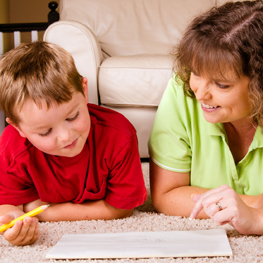
1. Start a family storytelling (and writing) tradition. Look through old family photographs. Tell your children stories based onwhat the photos show. Point out family members. Talk about what was happening. Then look at more recent photos and ask your child to tell a story based on what they see and remember. Together, write the story stimulated by the photo.
2. Build letter-writing skills. Using colored paper or designed stationery, show your child how to write ‘old-fashioned’ handwritten notes. Thank-you letters for gifts or outings are a good place to start - and always appreciated by grandparents! You may want to write out a simple sample letter for your child to copy.
3. Enjoy a nature hunt and research. When the ground is not fully snow-covered, plan an afternoon out in nature. Keep track of small animals and birds you see. (You may even find bugs under logs!) At home, have your child draw pictures of what they saw and look them up on the Internet. Your child can write one or two facts alongside each drawing and start to build a nature journal.
4. Have a cooking adventure! Include your child in the making of a fruit pie. Show them the fruit pie recipe you’d like to bake. Together, read the ingredients list and have your child gather the supplies and utensils. Read aloud each step, in order, as you build the pie together. Beforehand, you can expand the fun (and learning) by including your child in the shopping for ingredients and selecting the fruit.
5. Create your family calendar. Calendars help young children learn the basics of the days of the week and the months of the year. Have your child write family members’ birthdays onto the calendar. And help your child identify and list interesting words suited for each month. The words might be related to the weather or family activities that will occur like family vacations or visits with other relatives.
6. Maximize family outings and experiences. When you plan to visit a museum, art gallery or the zoo, for example, visit the destination’s website first. You and your child can check out all there is to see and do. If certain exhibits or activities occur on a schedule, help your child write out your itinerary so you can experience things most of interest to your family. The website may have games, maps and fun facts to explore too.
7. Start a collection. Does anyone in your family collect stamps, coins, rocks or commemorative spoons? Get them out and talk about them. Perhaps your child would like to start their own collection. Help them explore the Internet for ideas of what to collect. Help them start a logbook to document their collection with interesting facts about each item.
8. Take teddy on a journey. Help your child plan a journey for their favorite stuffed animal. Have them pick a destination and look it up on the Internet. Check out things to do there. Have your child write out what teddy will do over three days. Help your child make teddy’s suitcase packing list too. Perhaps teddy will also write a journal about their experiences (with your child’s help!) after teddy has taken their imaginary vacation.
9. Make your own comic strip. There are several online resources to help you and your child create their own comic strip. It’s a fun way for your child to draw, play and stimulate their imagination as they create fantasy worlds and unique characters. Creating comics can help your child develop their love of reading and improve their handwriting skills.
10. Plan a treasure hunt. This activity stimulates reading and problem-solving. You may have a theme like pirates, dinosaurs or princesses. Write out clues suitable for the ages of the children playing. Use the clues to send the kids hunting around the house or yard (if weather allows) and at each successful ‘destination,’ have the next clue waiting. Provide a treasure chest of inexpensive prizes at the end... perhaps new storybooks on theme too!
Calgary Reads innovates and inspires the reading revival, because we all have a role to play in creating a thriving community where all children can read with confidence and joy! Visit the website, calgaryreads.com, for videos, resources and games to help you build the joy of reading in your child.
Calgary’s Child Magazine © 2024 Calgary’s Child